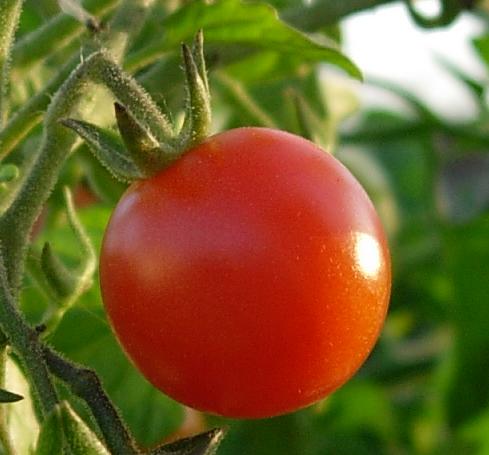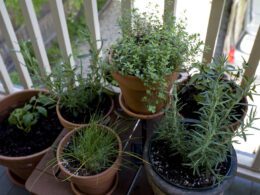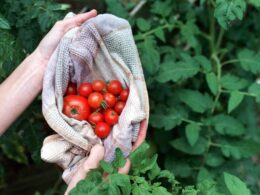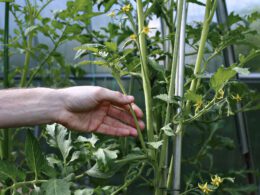Do you have a garden full of tomatoes that are blooming but never setting fruit? You’re not alone. Many gardeners find themselves in the same predicament. Don’t be discouraged! There are several potential causes and solutions for this common issue.
In this article, we will explore why your tomatoes may not be producing fruit, as well as what you can do to fix it. We will look at factors such as temperature, pollination, nitrogen levels, shade exposure, water intake, and pruning habits to determine why your tomatoes aren’t delivering the juicy fruits you were hoping for.
With a little bit of effort and some simple adjustments to your gardening routine, you can turn things around and get those delicious tomatoes on the vine!
Temperature
If temperatures are too high or too low, it won’t be possible for your plants to form fruit despite their blooming. Wind exposure and soil acidity can also play a role in the success of tomatoes setting fruit.
Too much wind can cause flowers to die off before they have the chance to be pollinated, while acidic soil can prevent nutrient uptake by the plant, ultimately leading to fewer fruits being formed.
It’s important to keep your tomato plants in an environment with controlled temperatures and proper exposure to wind. If you’re growing them indoors, position them near windows that offer indirect sunlight throughout the day so they don’t overheat. Additionally, make sure there is enough air circulation inside your house so that any wind from outside doesn’t blow directly onto the plants.
To ensure that your tomatoes are getting all of the nutrients they need in order for them set fruit, it’s essential to check if your soil is acidic or not. You can purchase a pH testing kit at any gardening store and use it on a sample of soil taken from around your tomato plants. If necessary, you may need to add lime or dolomite powder into the ground in order balance out its acidity levels.
Pollination
You may be wondering why your tomato plants are blooming but not producing fruit – let’s explore the role of pollination in this process.
Pollination is a critical step in the production of tomatoes, and it relies on a variety of factors:
- The presence of insects such as bees, wasps, flies, and butterflies;
- The availability of nectar for these pollinators to feed on;
- The abundance or lack thereof of certain species that may affect the population size of pollinators; and
- The weather conditions that can influence the flight patterns of pollinators.
Without adequate insect population numbers or suitable weather conditions for their flight paths, it can be difficult for even the most hardy tomato plant to produce fruit.
For instance, if there are fewer bees in an area due to environmental changes or pesticide use, then tomatoes will have difficulty being fertilized by pollinators. Furthermore, if pollen-carrying insects cannot fly because of cold temperatures or heavy rain showers during bloom time then tomato plants will likely fail to set fruit.
It’s important to understand how these components interact with each other when trying to determine why your tomatoes aren’t setting fruit but only blooming.
By examining the environment around your garden and taking into account variables such as insect populations and weather conditions, you should be able to identify potential issues that could be preventing successful pollination from occurring.
Too Much Nitrogen
Too much nitrogen in the soil can prevent your tomato plants from producing fruit, even if they’re blooming. Nitrogen is important for all plants and essential for proper growth and development.
However, when the soil has too much nitrogen, it can lead to a deficiency of other important nutrients that are necessary for setting fruit. This imbalance in soil fertility can be caused by over-fertilizing or composting with high concentrations of nitrogen-rich materials like grass clippings or manure.
If you suspect your tomato plants have received too much nitrogen, reduce or stop adding any fertilizer until symptoms improve. Incorporating a balanced fertilizer into your planting bed will help ensure all essential nutrients are present in equal amounts for optimal plant health and fruiting success.
Checking pH levels regularly is also essential, as this can affect how available certain nutrients are for uptake by the plant roots. To ensure healthy blooms and bountiful fruits on your tomato plants, make sure they’re receiving adequate nutrition throughout their growing season!
Regularly testing soil fertility levels can help you identify potential nutrient deficiencies before they become a bigger issue down the road.
Too Much Shade
Excessive shade can impede the growth of tomato plants, compromising their ability to produce abundant fruits. Tomatoes require full sun for at least 6 hours a day in order to set fruit and thrive. Lack of light can cause the flowers to drop off without setting fruit, while excessive humidity can increase the incidence of fungal diseases such as blight or leaf spot.
To ensure your tomatoes receive enough sunlight, try planting them in an area that receives direct sunlight throughout the day and avoid areas with excessive shade from trees or buildings. Additionally, make sure there’s adequate air circulation around your plants and prune away any foliage that blocks out light.
To protect your tomato plants from too much humidity, practice good garden hygiene by removing any diseased leaves or debris that may harbor fungus spores. These can spread disease quickly between plants if left unchecked. In addition, water your plants early in the morning so they have time to dry off before nightfall when temperatures are cooler and moisture lingers longer on plant surfaces.
Finally, consider using soilless potting mixes for container-grown tomatoes as these typically provide better drainage than traditional soil-based mixes. These tend to retain more moisture near plant roots.
Is Lack of Fruit Production Related to Tomato Plants Only Growing Leaves?
Is lack of fruit production related to tomatoes with only leaf growth? It is possible. If tomato plants focus primarily on leaf growth, they might not allocate enough resources for fruit development. Factors like insufficient pollination, inadequate sunlight, or nutrient imbalances can also hinder fruit production. To encourage fruiting, ensure your tomato plants receive proper care, including regular pruning, adequate fertilization, and optimal growing conditions.
Insufficient Water
Insufficient water can stunt tomato plants’ growth and prevent them from achieving their full potential, robbing them of the opportunity to produce vibrant blooms and juicy fruits. Without enough moisture, a plant’s roots can’t absorb the nutrients they need for proper development. This can lead to stunted growth and reduced root health, which then affects the overall soil fertility.
When this happens, tomatoes won’t be able to set fruit as their energy is devoted towards providing just enough nourishment for survival rather than expanding into fruit production. But there are ways to improve water availability for your tomatoes: use mulch around your plants to help retain moisture in the soil; water deeply but infrequently; check if using a soaker or drip system would benefit your garden; and make sure that you’re planting in soil with good drainage so that excess water doesn’t pool around the roots of your plants.
Taking these steps will help ensure that your tomatoes get enough water to thrive and will give them the best chance at producing luscious fruits. By giving tomatoes adequate amounts of hydration through smart gardening practices, you’ll be able to create an environment where they can reach their full potential – with beautiful blooms followed by delicious fruits!
Too Much Pruning
Pruning your tomato plants too much will limit their ability to produce vibrant blooms and juicy fruits. It can be difficult to find the right balance between pruning and not over-pruning.
Over-pruning limits the number of branches, which in turn reduces the amount of foliage available for photosynthesis, a process that helps create energy for fruit growth. On top of this, over-pruning can also lead to an increase in water loss from the soil because there’s less foliage to protect it from sunlight and wind. This can further affect soil quality, resulting in a decrease of essential nutrients like nitrogen and phosphorus needed for healthy plant growth.
When it comes to pruning your tomato plants, remember that less is more! Prune just enough so that you’re removing dead or diseased branches while keeping the overall form of the plant intact; then let nature take its course!
Keep in mind that if you’re watering your tomatoes adequately, they should be able to grow healthy foliage without needing too much pruning anyway. Additionally, make sure you keep an eye on soil quality by checking pH levels and adding compost periodically so your tomatoes get all the nutrients they need for strong blooms and fruiting potential.
Tomatoes require careful care when it comes to pruning; if done correctly, you’ll be rewarded with beautiful flowers and delicious fruits! Take into account both water needs as well as soil quality when considering how much you should prune – doing this will ensure proper nutrition for healthy blooming and fruiting throughout the season.
Frequently Asked Questions
What type of soil is best for tomatoes?
When it comes to growing healthy tomatoes, the soil you use is one of the most important elements. Soil that is too sandy or clay-like can lead to poor growth and limited fruit production.
For optimal results, look for a well-draining soil with plenty of organic matter like compost or leaf mold. To ensure your tomatoes are getting all the nutrients they need, test the pH of your soil (ideally between 6.2 – 7.0) and consider mulching techniques to help keep moisture in and weeds out.
With a little extra attention to your tomato’s soil conditions, you’ll be sure to get an abundance of delicious fruits this season!
What is the optimal temperature for tomato growth?
Growing tomatoes indoors can be tricky, but with the right temperature, you can have a successful harvest.
The optimal temperature for tomato growth is between 70-85 degrees Fahrenheit during the day, and 55-70 degrees at night. If temperatures drop below 55 at night, it may cause your tomatoes to not set fruit.
Temperature fluctuations beyond this range will limit the productivity of your plants. To ensure success when growing tomatoes indoors, make sure that the daytime temperature stays within this range, and don’t let it dip below 55 degrees in the evening.
With careful attention to these parameters, you’re sure to have a great indoor harvest!
How often should tomatoes be fertilized?
Fertilizing your tomatoes is an important part of ensuring a healthy crop. The fertilizer type and quantity will depend on the type of tomato you’re growing, as well as the soil conditions. Generally speaking, tomatoes should be fertilized every two weeks with a balanced fertilizer that contains Nitrogen (N), Phosphorus (P), and Potassium (K).
For best results, use a liquid fertilizer rather than granules to ensure even coverage over the soil surface. Additionally, for an extra boost of nutrients, consider adding a compost tea to your tomato plants once or twice per season.
With proper care and fertilization, you can ensure that your tomatoes have all they need to thrive!
How often should tomatoes be pruned?
Pruning your tomatoes is an important gardening task that should be done on a regular basis. This will help keep your plants healthy and allow them to get the most out of their growth season.
To prune effectively, it’s important to know the proper techniques and methods. You’ll want to focus on removing dead or damaged leaves, thinning out dense foliage, and cutting off any suckers that are growing from the main stem. Additionally, pollination can be increased by removing some of the lower branches so more air circulates through the plant.
Pruning your tomatoes regularly is essential for getting the best results from your garden!
How can I tell if my tomatoes are getting enough water?
If you’re wondering how to tell if your tomatoes are getting enough water, here’s how:
- Look at the soil moisture levels and quantity of water you’re giving them.
- Dig a finger into the soil around your tomato plants and feel for moisture.
- If it’s damp, then the plants are likely getting enough water.
- If it feels dry, then they may need more.
Also, check the watering schedule you’ve set up for your tomatoes. They should be receiving 1-2 inches of water per week during their growing season.
With this information, you’ll be able to adjust your watering routine as needed to ensure that your tomatoes get just the right amount of hydration!
Conclusion
Are you wondering why your tomatoes aren’t setting fruit? It could be because of temperature, pollination, too much nitrogen, too much shade, insufficient water, or too much pruning.
All these factors can prevent your tomatoes from producing the delicious fruits they’re capable of! Make sure to take a look at the environmental conditions around your plants and adjust accordingly.
You’ll be rewarded with an abundance of flavorful tomatoes soon enough.









